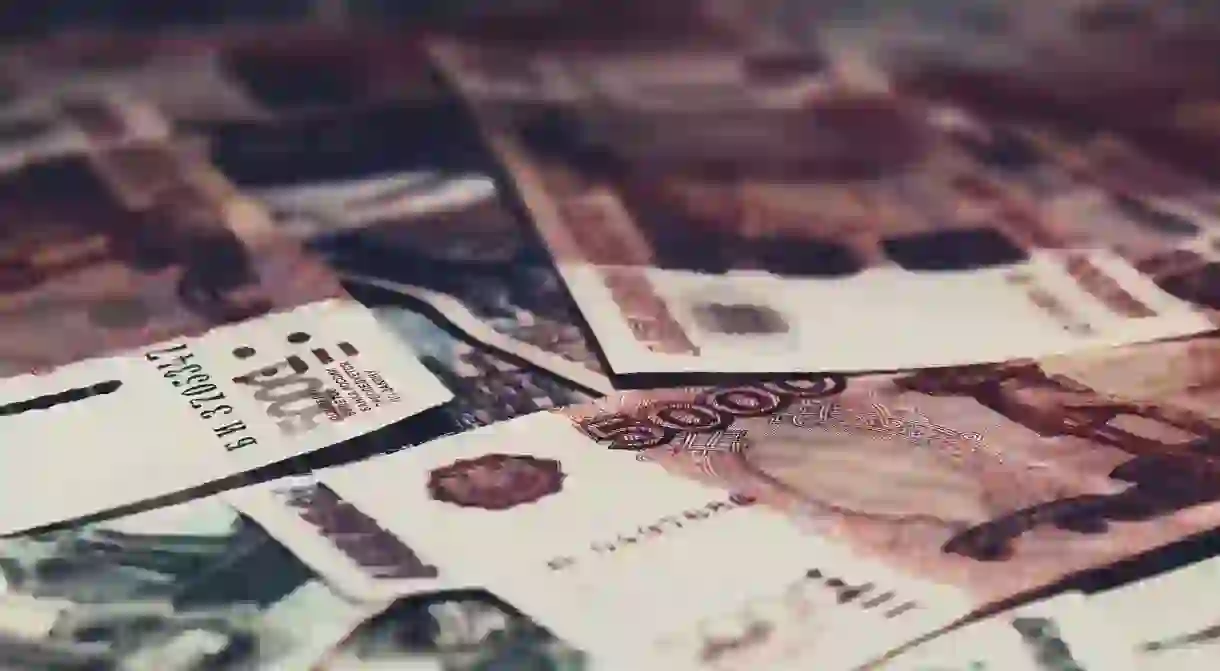RUB: Explaining the Rouble, Russia's Currency

The Russian rouble has had a rocky few years since the start of international sanctions on Russia. The exchange rate was as unpredictable as the weather for a while. Currently, the exchange rate is very favourable for visitors buying roubles with a strong currency, and a trip to Russia will prove to be money well spent.
A brief history
The first mention of the rouble dates back to the time when Russia was divided into a number of independent states. The city of Novgorod oval silver casts, called grivnas, were in use. Those could be further cut down into smaller pieces, which were referred to as roubles, meaning something that has been cut. In the 16th century, after all of Russia’s lands were united under one tsar, a currency reform was necessary. One rouble was used as a counting name for 100 smaller coins, kopeks, which are still in use today. Yet, a separate rouble coin only appeared in the 18th century, during the reign of Peter the Great. These new rouble coins were the equivalent of 28 grammes of silver and equal to 100 kopek coins made of copper. The content of silver in the rouble varied throughout time. Later in the 18th century, government banks began to issue paper money, called the assignation rouble, which in turn was replaced by state credit notes in 1843. After the Russian revolution of 1917 and the formation of the Soviet Union, the Soviet rouble replaced the Imperial rouble. The Soviet rouble was used in all 15 Soviet states, and some continued using it after the fall of the Union in 1991.

The rouble today
The rouble we know now co-existed with the Soviet rouble for two years. As the country was undergoing a challenging transition to a new political and economic system, citizens were also gradually cashing in their Soviet roubles in exchange for the new ones. A hard time started for the rouble in 2014 after crippling economic sanctions were imposed on Russia following the annexation of Crimea. The rouble significantly lost its value in comparison to other world currencies, as a result causing retailers to increase their prices, although salaries and pensions remained the same. The current exchange rates hover around 50-60 roubles for 1 US dollar.

Notes
The banknotes used in Russia now first appeared in 1998. The size and design of the notes are the same for all the values. They do differ, through, in colour and in the images used on the notes. Each note is dedicated to a particular city with prominent landmarks depicted on either side. The most common banknotes in use are the 50, 100, 500, 1000 and 5000 notes. The 10-rouble note can also sometimes be seen, but is gradually being replaced with a coin of equivalent value. In 2017, two new additions were made: a 200- and 2000-rouble banknote, yet these two are still a rare sight and are gradually being introduced into circulation.

What will your money get you?
50 rubles (approx. US$0.80)
In today’s economy, 50 roubles won’t get you very far. Especially when exploring touristy areas of a city, prices will be slightly escalated and higher than in a more residential neighbourhood. In most cities, with the exception of Moscow, it will be just enough to buy a one-way bus or subway ticket, so always have one handy when travelling on public transport.
100 rubles (approx. US$1.60)
Most basics in a grocery store will cost less, or around 100 roubles. You could get a bottle of water, a snack bar, some fruit and maybe even a coffee in a local chain. It will also be enough to buy a return ticket on a suburban train to explore the environs of a city.
500 rubles (approx. US$8)
A more useful amount to spend, 500 rubles can easily buy a breakfast, lunch or even an inexpensive dinner. Most tickets to museums will cost within the 500-ruble range, although sometimes very popular attractions feel confident to charge even more than that. In rainy weather, 5o0 rubles can also get you a short cab ride within a 20-30 minutes’ driving distance.
1000 rubles (approx. US$16)
Just over 1000 roubles is an amount you would spend on a nice dinner with wine or will get your groceries for the week. It really depends on how you choose to spend it. A couple thousand is also a good amount to put aside on your trip if you’ll be getting souvenirs sometime down the road.
5000 roubles (approx. US$80)
A 5000-rouble note can get you a lot of things, so it’s best not to carry these around in large stashes. It would pay for a few nights in a standard hotel or buy a ticket from St Petersburg to Moscow by high-speed train.

Tips for splashing your cash
It’s useful to have cash on you, as many small businesses, like street stalls, won’t accept credit cards. The buses also still run on a cash system, and tickets are purchased on board. Make sure to have a smaller note for these occasions, as vendors may simply not have enough change to give you.
Be careful about where you exchange your money. Do so only at a bank, hotel or proper exchange office. Street traders may give you a good rate, but they may also hand over fake currency. Remember that exchanges in other currencies are illegal, so don’t become an accomplice.
Tipping is customary in Russian restaurants, as wages are often fairly low. Aim for the usual 10%, or 15% if you’ve had exceptional service. Coffee shops and on-the-go places will usually have a tip jar, but don’t feel obliged to tip in a place with no wait staff.














